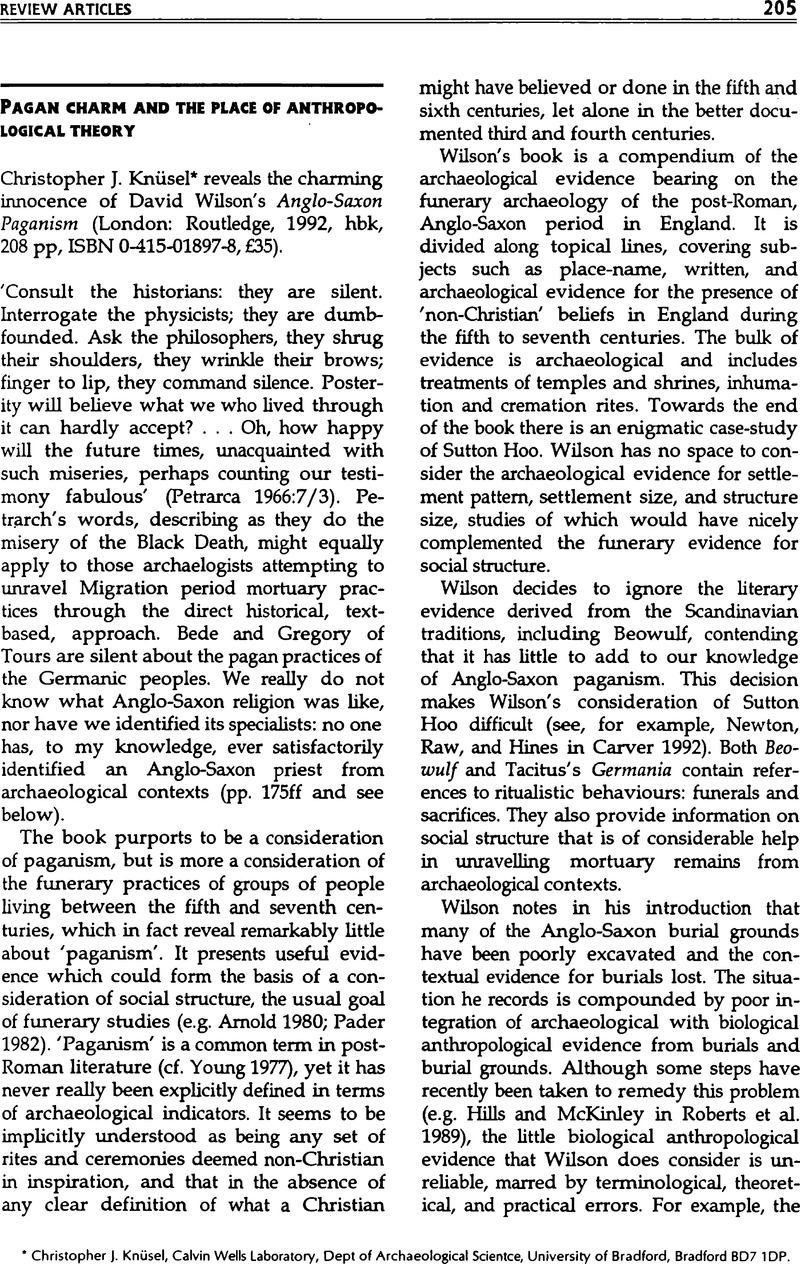No CrossRef data available.
Article contents
Pagan charm and the place of anthropological theory
Published online by Cambridge University Press: 27 January 2017
Abstract
An abstract is not available for this content so a preview has been provided. Please use the Get access link above for information on how to access this content.

- Type
- Review Articles
- Information
- Copyright
- Copyright © European Association of Archaeologists
References
Arnold, Christopher, 1980. Wealth and social structure: a matter of life and death. In Philip, A. Rahtz et al. (eds), Anglo-Saxon Cemeteries: 81–142. Oxford: British Archaeological Reports (Brit. Ser. 82).Google Scholar
Binford, Louis R., 1971. Mortuary practices: their study and potential. In Brown, J. A. (ed.), Approaches to the Social Dimensions of Mortuary Practices: 6–21. Society for American Archaeology (Memoirs of the SAA 25).CrossRefGoogle Scholar
Callender, C. and Kochems, L. M., 1983. The North American berdache. Current Anthropology
24: 443–470.CrossRefGoogle Scholar
Chapman, Robert, 1987. Mortuary practices: society, theory building and archaeology. In Boddington, A., Garland, N., and Janaway, R. C. (eds.), Death, Decay and Reconstruction: 198–213. Manchester: Manchester University Press.Google Scholar
Fulton, R. and Anderson, S. W., 1992. The Amerindian ‘man-woman’: gender, liminality, and cultural continuity. Current Anthropology
33: 603–610.CrossRefGoogle Scholar
Hawkes, Sonia C. and Wells, C., 1975. Crime and punishment in an Anglo-Saxon cemetery?
Antiquity
49: 118–122.CrossRefGoogle Scholar
Hills, Catherine and McKinley, J. I., 1989. Spong Hill Anglo-Saxon cemetery. In Roberts, C. A., Lee, F., and Bintliff, J. (eds.), Burial Archaeology, Current Research, Methods, and Developments: 237–248. Oxford: British Archaeological Reports (Brit. Ser. 211).Google Scholar
Hines, John, 1992. The Scandinavian character of Anglian England: an update. In Martin, O. H. Carver (ed.), The Age of Sutton Hoo. Woodbridge: Boydell Press.Google Scholar
James, Edward, 1989. Burial and status in the early medieval West. Transactions of the Royal Historical Society
5th ser.
39:
23–40.CrossRefGoogle Scholar
Mauss, Marcel, 1990. The Gift: the form and reason for exchange in archaic societies. Trans. by Halls, W. D.
London: Routledge.Google Scholar
Newton, S., 1992. Beowulf and the East Anglian royal pedigree. In Martin, O. H. Carver (ed.), The Age of Sutton Hoo. Woodbridge: Boydell Press.Google Scholar
O'Shea, John, 1981. Social configurations and the archaeological study of mortuary practices: a case study. In Robert, Chapman, Ian, Kinnes, and Klavs, Randsborg (eds), The Archaeology of Death: 39–52. Cambridge: Cambridge University Press.Google Scholar
O'Shea, John, 1984. Mortuary Variability: An Archaeological Investigation. Orlando: Academic Press.Google Scholar
Pader, Ellen-Jane, 1982. Symbolism, Social Relations and the Interpretation of Mortuary Remains. Oxford: British Archaeological Reports. (Brit. Ser. 130).CrossRefGoogle Scholar
Parker-Pearson, Michael, 1982. Mortuary practices, society, and ideology: an ethno-archaeological case study. In Ian, Hodder (ed.), Symbolic and Structural Archaeology. Cambridge: Cambridge University Press.Google Scholar
Parker-Pearson, Michael, 1992. Tombs and monumentality in southern Madagascar: preliminary results of the central Androy survey. Antiquity
66: 941–948.CrossRefGoogle Scholar
Petrarca, Francesco, 1966. Letters. Trans. by Morris, Bishop.
Bloomington: Indiana University Press.Google Scholar
Randsborg, Klavs, 1981. Burial, succession, and early state formation in Denmark. In Robert, Chapman, Ian, Kinnes, and Klavs, Randsborg (eds), The Archaeology of Death: 105–121. London: Carlisle Press.Google Scholar
Raw, B., 1992. Royal power and royal symbols in Beowulf. In Martin, O. H. Carver (ed.), The Age of Sutton Hoo. Woodbridge, GB: Boydell Press.Google Scholar
Service, Elman, 1962. Primitive Social Organization, an Evolutionary Perspective. New York: Random House.Google Scholar
Schutkowski, H., 1993. Sex determination of infant and juvenile skeletons: I morphog-nostic features. American Journal of Physical Anthropology
90: 199–205.CrossRefGoogle ScholarPubMed
Tainter, J. A., 1977. Modeling social change in prehistoric social systems. In Louis, R. Binford (ed.), For Theory Building in Archaeology: 327–351. New York: Academic Press.Google Scholar
Young, Bailey K., 1975. Merovingian Funeral Rites and the Evolution of Christianity: a study in the historical interpretation of archaeological material. , University of Pennsylvania, Philadelphia.Google Scholar
Young, Bailey, K., 1977. Paganisme, christianisation et rites funéraires méovingiens. Archéologie Médiévale
7: 5–81.CrossRefGoogle Scholar




